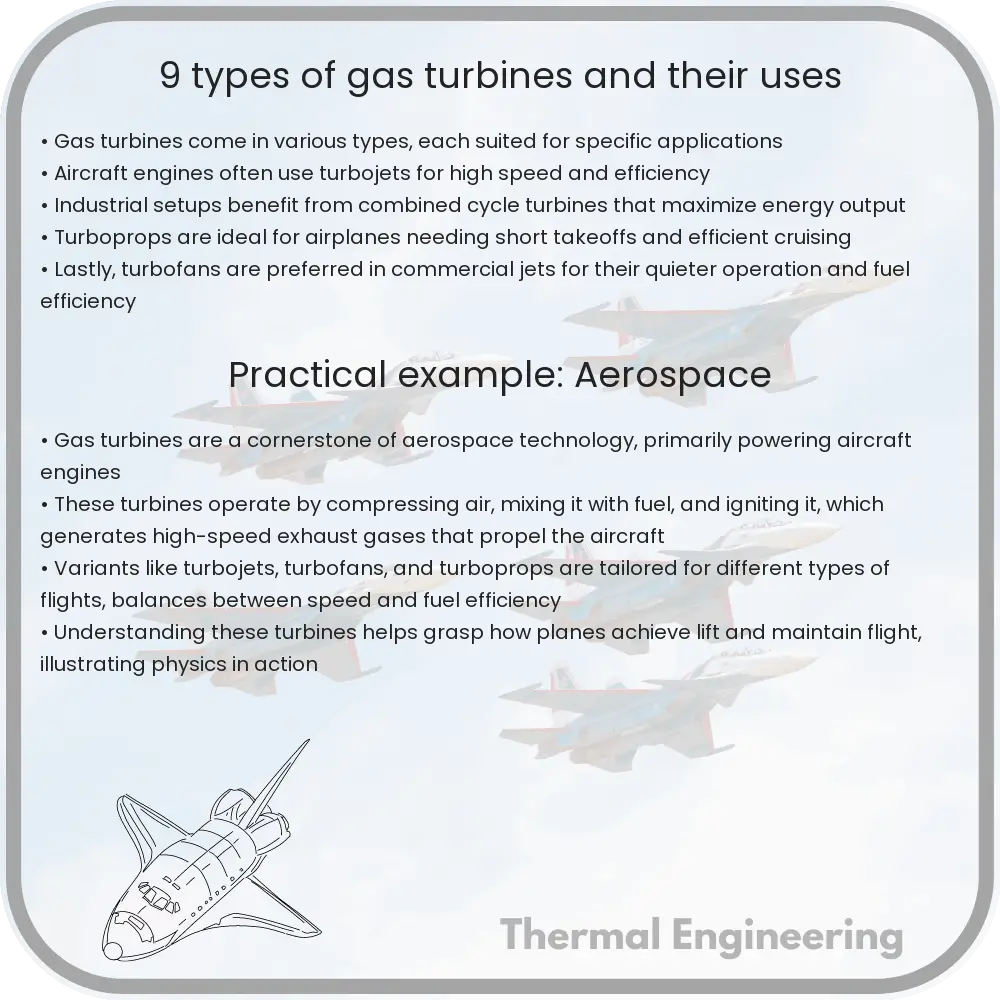Learn about the various types and uses of gas turbines, from power generation to aircraft propulsion.

Introduction to Gas Turbines
Gas turbines are a crucial component in various engineering applications, ranging from power generation to aircraft propulsion. These machines convert natural gas or other fuels into mechanical energy, which in turn can be converted into electrical power or used to propel an aircraft. Understanding the different types of gas turbines and their specific applications is essential for professionals in engineering and related fields.
Types of Gas Turbines and Their Uses
- Aero-Derivative Gas Turbines
- Industrial (Heavy-Duty) Gas Turbines
- Microturbines
- Radial Gas Turbines
- Turboshaft Engines
- Turbojet Engines
- Turbofan Engines
- Gas Turbine Locomotives
- Marine Gas Turbines
As the name suggests, aero-derivative gas turbines are derived from jet engine designs and are optimized for mobility and flexibility. They are lighter and can start up or shut down quickly, making them ideal for providing temporary power or serving as backup systems in emergencies. They are commonly used in applications where quick power is needed, such as in peak shaving for electric utilities and in portable power plants.
Industrial gas turbines are designed for stationary power generation. These turbines are larger and more robust, specially engineered for long-term use. They are prominently used in power plants and in industrial environments where reliable, continuous power output is a priority. Compared to aero-derivatives, they have a higher power output and are more efficient in continuous operation scenarios.
Microturbines are small combustion turbines that can produce up to 1000 kilowatts of power. They are used in small scale power generation applications and more commonly in combined heat and power (CHP) systems. Their compact size makes them suitable for residential buildings, small businesses, and remote locations like oil and gas fields.
Radial gas turbines are characterized by their radial flow compressors and turbines, as opposed to the more common axial flow in larger turbines. They are typically used in small applications, such as in auxiliary power units (APUs) for aircraft or in compact machinery where space is a constraint.
Turboshaft engines are a type of gas turbine optimized to produce shaft power rather than jet thrust. They are primarily used in helicopters and other aircraft where a compact, high-power engine is required. Beyond aviation, they are also used in power generation and marine propulsion.
Turbojet engines were among the first types of gas turbines developed. They generate thrust by ejecting a high-speed jet of gases. These engines are mainly used in older model aircraft. Although largely superseded by more efficient turbine designs, turbojets are still used in specific military applications and for research purposes.
Turbofan engines are the most common type found in modern commercial aircraft. They are similar to turbojets but include a fan that produces additional thrust by bypassing the core turbine, improving efficiency. This makes turbofan engines suited for commercial airliners, which require both high thrust and good fuel efficiency.
While not as common today, gas turbine locomotives were explored as an alternative to diesel engines, particularly in the mid-20th century. Offering powerful performance, these locomotives were used primarily during periods of low diesel fuel availability but were eventually phased out due to high fuel consumption and operational costs.
Used primarily in fast ships like frigates and corvettes, marine gas turbines are valued for their high power-to-weight ratio, a critical factor in naval applications. These turbines are similar to aero-derivative turbines, optimized for the sea environment where quick acceleration and high-speed operation are required.
Conclusion
Gas turbines play a pivotal role in both everyday and specialized applications. From powering the largest power plants to propelling high-speed jets, the versatility and efficiency of gas turbines make them indispensable in modern engineering. Understanding the different types of gas turbines helps in selecting the right turbine for the right application, ultimately leading to better performance and efficiency.